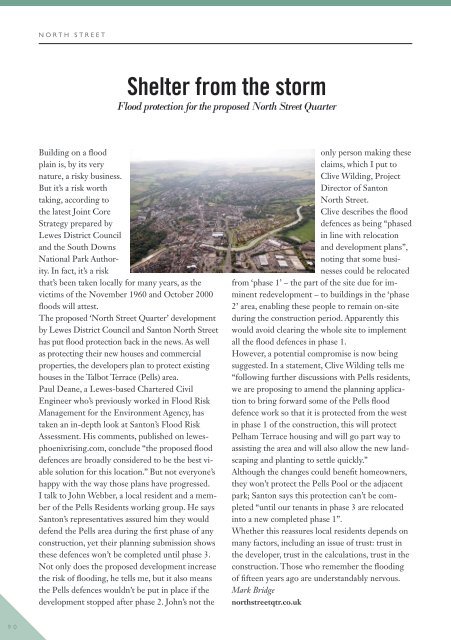Viva Lewes June 2015 Issue #105
Create successful ePaper yourself
Turn your PDF publications into a flip-book with our unique Google optimized e-Paper software.
north street<br />
Shelter from the storm<br />
Flood protection for the proposed North Street Quarter<br />
Building on a flood<br />
plain is, by its very<br />
nature, a risky business.<br />
But it’s a risk worth<br />
taking, according to<br />
the latest Joint Core<br />
Strategy prepared by<br />
<strong>Lewes</strong> District Council<br />
and the South Downs<br />
National Park Authority.<br />
In fact, it’s a risk<br />
that’s been taken locally for many years, as the<br />
victims of the November 1960 and October 2000<br />
floods will attest.<br />
The proposed ‘North Street Quarter’ development<br />
by <strong>Lewes</strong> District Council and Santon North Street<br />
has put flood protection back in the news. As well<br />
as protecting their new houses and commercial<br />
properties, the developers plan to protect existing<br />
houses in the Talbot Terrace (Pells) area.<br />
Paul Deane, a <strong>Lewes</strong>-based Chartered Civil<br />
Engineer who’s previously worked in Flood Risk<br />
Management for the Environment Agency, has<br />
taken an in-depth look at Santon’s Flood Risk<br />
Assessment. His comments, published on lewesphoenixrising.com,<br />
conclude “the proposed flood<br />
defences are broadly considered to be the best viable<br />
solution for this location.” But not everyone’s<br />
happy with the way those plans have progressed.<br />
I talk to John Webber, a local resident and a member<br />
of the Pells Residents working group. He says<br />
Santon’s representatives assured him they would<br />
defend the Pells area during the first phase of any<br />
construction, yet their planning submission shows<br />
these defences won’t be completed until phase 3.<br />
Not only does the proposed development increase<br />
the risk of flooding, he tells me, but it also means<br />
the Pells defences wouldn’t be put in place if the<br />
development stopped after phase 2. John’s not the<br />
only person making these<br />
claims, which I put to<br />
Clive Wilding, Project<br />
Director of Santon<br />
North Street.<br />
Clive describes the flood<br />
defences as being “phased<br />
in line with relocation<br />
and development plans”,<br />
noting that some businesses<br />
could be relocated<br />
from ‘phase 1’ – the part of the site due for imminent<br />
redevelopment – to buildings in the ‘phase<br />
2’ area, enabling these people to remain on-site<br />
during the construction period. Apparently this<br />
would avoid clearing the whole site to implement<br />
all the flood defences in phase 1.<br />
However, a potential compromise is now being<br />
suggested. In a statement, Clive Wilding tells me<br />
“following further discussions with Pells residents,<br />
we are proposing to amend the planning application<br />
to bring forward some of the Pells flood<br />
defence work so that it is protected from the west<br />
in phase 1 of the construction, this will protect<br />
Pelham Terrace housing and will go part way to<br />
assisting the area and will also allow the new landscaping<br />
and planting to settle quickly.”<br />
Although the changes could benefit homeowners,<br />
they won’t protect the Pells Pool or the adjacent<br />
park; Santon says this protection can’t be completed<br />
“until our tenants in phase 3 are relocated<br />
into a new completed phase 1”.<br />
Whether this reassures local residents depends on<br />
many factors, including an issue of trust: trust in<br />
the developer, trust in the calculations, trust in the<br />
construction. Those who remember the flooding<br />
of fifteen years ago are understandably nervous.<br />
Mark Bridge<br />
northstreetqtr.co.uk<br />
90


















